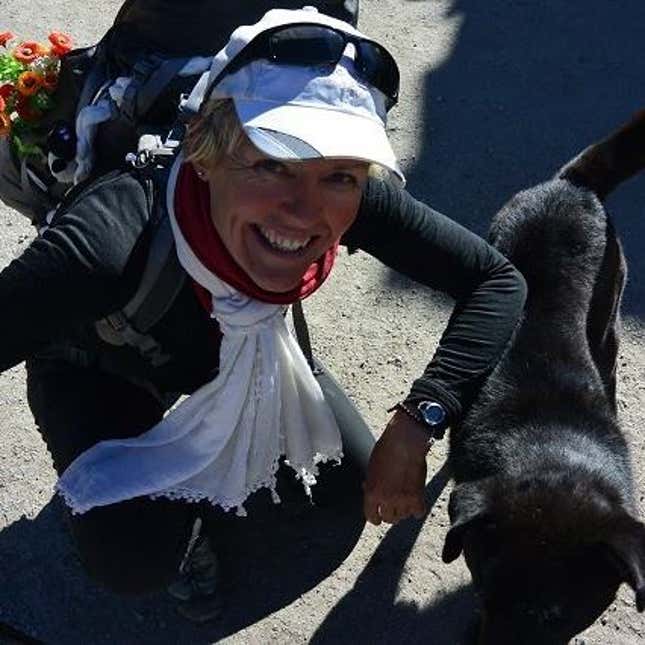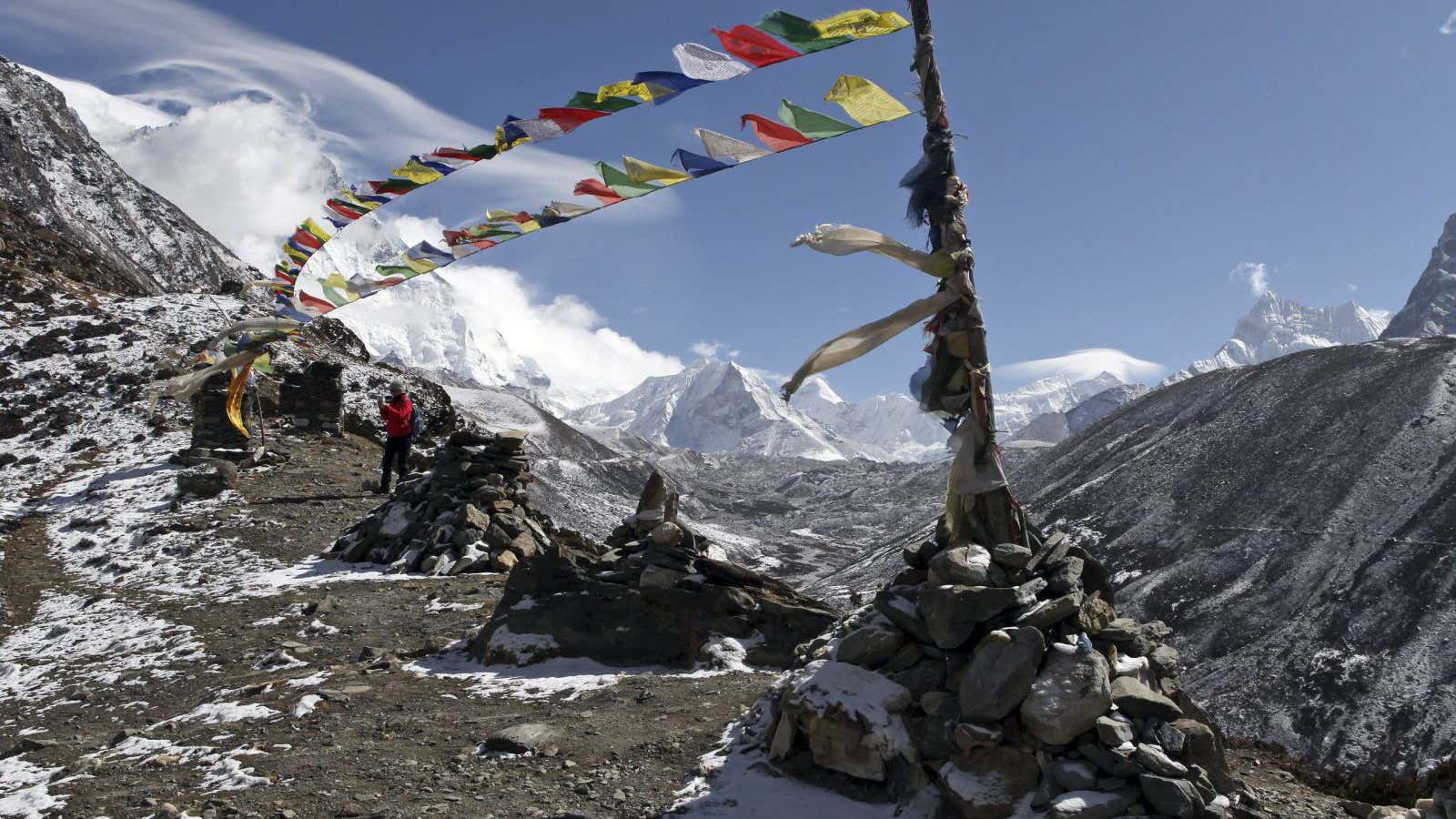I met Mel Southworth at on April 26, 2015, at Everest Base Camp, the day after a 7.8-magnitude earthquake had rocked Nepal and sent an avalanche crashing through our city of tents underneath the world’s highest mountain. Southworth was surveying the damage at Base Camp for the first time; she had been in a nearby village, preparing to climb, when the quake struck the day before.

Southworth first came to Mount Everest in 2014, but—like all climbers that year—had to turn home early after an avalanche killed 16 Sherpas on the main climbing route. With her second shot at the summit foiled by another disaster, any disappointment she was feeling was outwardly overshadowed by the gratitude she offered to the Everest ER doctors for their work, by the heartbreak she felt for the people of Nepal, and by her determination to help clean up Base Camp.
Base Camp was littered with debris from the avalanche that had killed 19 people the day before. Twisted tent poles, overturned toilet pits, food, trash, and gear of all sorts had blown hundreds of feet across the glacier between the campsites and the main climbing route.
Still in shock from the previous day’s events, I didn’t particularly relish the thought of trekking through camp to pick up trash for hours on end. But I couldn’t say no to Southworth. Neither could the Indian army’s team of climbers, who rallied behind her and spent the next two days collecting all the garbage in sight.
As we worked together to sift through the debris, discovering smashed laptops and melted chocolate bars under the snow and hot sun at 17,500 feet, Southworth, who is from the UK, told me that she’d spent everything she had to come to Everest. She hinted that she would return again if given the chance.
Sure enough, this spring I learned that Southworth was headed to Nepal for her third attempt to summit Everest. I emailed her to ask why, and how, she could muster the energy to go through it all again. She gave me permission to publish her reply, lightly edited here for length and clarity:
Hi Svati…
Here are my thoughts…
As you may know, I’ve been visiting Nepal regularly for the past 25 years and particularly the Khumbu Everest valley for the last 15—the last three with the aim of climbing the world’s highest peak.
The first question people always want to know—which is a shame—is about money. How have I managed to come back for three potential beatings? Well, the short answer to that from me is this: I’m a middle-aged, working class woman with limited skill sets who decided it was a worthy cause to blow her retirement fund on fulfilling a life-long dream. And if that means I’ll be broke in my final years, so be it. I’ve no problem working at a check-out for the rest of my life if that’s what I’ll have to do to keep it together in my old age. Nobody these days cares if you climb Mount Everest, but purely for myself, I do. And it’s worth everything to me to at least attempt. So, in short, I’ve bankrupted myself.
There are a million and one ways to live a life. Everyone, including myself, blows money every year on meaningless things. We often forget that money facilitates how we live our lives, but it can’t buy us happiness or a longer life. I’ve had a family member work hard all his life and die prematurely at the very point he should have been enjoying the spoils of his success. I vowed that the same thing wouldn’t happen to me. I’ve chosen, instead, to spend most of my life traveling for no other reason than the sheer love of doing it, sacrificing having a family and stable home life as a byproduct. Life is short.
Climbing Everest is expensive. Period. It’s a fact that will never go away while Nepal remains one of the poorest countries in the world and Everest remains our highest mountain. Tackle the issue of poverty first, and then we can debate why only ‘rich people’ can afford to climb it.
There are many people here at Everest Base Camp who, like myself, are anything but rich. In any other world, no one would ever question a person’s right to buy a comparably priced commodity such as a BMW, but at Everest Base Camp, we’re like clay pigeons for every pot-shot-taking, armchair mountaineer in the world. There’s one tar brush that paints us all and it can be very upsetting. I’ve met some truly wonderful people over the last few years here, who have truly changed my life, and their bank balance has had little to do with it. It tickles me sometimes that we come here to try and climb a big mountain, yet can have a harder time defending our character.
Having spent over 25 years visiting and loving this country and its people, I, for one, feel I’ve earned the right to blow a bunch of cash trying to kill myself here. And at least I’ll do it amongst friends.
Notwithstanding the financial sacrifices necessary to return a third year running, by far the greatest challenge for me has been maintaining mental and emotional focus, especially after the unbearable loss of life over the last few years. This is something that I doubt I shall ever come to terms with. It takes a tremendous amount of mental strength and stamina to undertake to climb a big mountain under the best of conditions and, having climbed Lhotse, the fourth-highest mountain and a neighbor of Everest, I know exactly what that entails.
Ignorance, for me, is not bliss. I’ve walked under those seracs and I know what can happen. I know the risks.
But in light of the last few years, there’s an added burden.
From an emotional point of view, I’ve seen and experienced too much. And that will sit with me for the rest of my life. The shadow of death—something that we all avoid to the point of denial—is a constant here.
Being of a naturally sunny disposition, I’d say the greatest thing that I’ve sacrificed over the last three years has been a chunk of that glowing optimism about life and wild places. Tragedy brings out the best and worst in people and I have seen my fair share of both. It’s difficult not to become hardened by things that you have seen—a constantly inept government in a country that you love, screwing its own people; a small proportion of people with a worldwide image of goodness, thieving like magpies amongst the chaos of a natural disaster; the disappointment of watching people you know and love not always doing the right thing, including yourself. It’s a curing of the soul that can be brutal. Perhaps some of us come to these environments to challenge ourselves for that very reason; because on a primitive level we haven’t had enough time to evolve from the hard-living species that we were such a short time ago and we struggle with this new type of life.
At the end of the day Everest will always cast its magnetic charm regardless of whatever happens in the Himalaya, especially for me. Trekking numbers this year are not affected to the extent indicated, although the demographic has shifted somewhat from previous years. Far fewer Brits and Germans, far more Russians and Eastern Europeans. But this I feel has more to do with economics than nervousness about visiting Nepal.
Understandably climbing numbers are down from 2014/2015, but not to the extent that I expected. Although if you remove the quantity of returnees from last year, then yes, numbers are significantly reduced. I am somewhat surprised at the amount of people who are returning for their second or third attempt, but I think there is a general feeling of ‘we’ve been through it all anyway’… and ‘surely something can’t happen a third year in a row?’
Regular climbers without deep pockets have had to scramble any which way in order to be able to return. Some operators have shown a generosity of spirit in making it as affordable as possible for those returning, but, needless to say, a fair share who are feeling the pinch have had no shame [and] put their hands in other people’s pockets to balance the books.
Climbing the highest mountain on Earth has little value to those who do not understand why we attempt to do so. And that’s fine. We’re all the centre of our own universe at the end of the day, with our own likes and dislikes, and we wouldn’t have it any other way. But to end on a positive note about Everest, I have to attempt to share what is so captivating and addictive about this landscape and why I have spent so much time coming here.
Regardless of whoever you are—be that a film maker, an airline pilot, a plumber, an aspiring writer such as myself, you name it—all of those titles and accolades get left behind in Kathmandu when you take your first step on the trail up the Khumbu Valley.
We all come to these mountains stripped and equal.
There is a magical, dare I even say spiritual, presence to these mountains. These mountains will ask questions of you that nothing else on earth has the power to do. You will not leave here without finding out who you truly are—what you are really made of—both the good and the bad.
I don’t have a personal god, but if I did, it would be here in this amphitheatre of unforgiving rock and ice.
We’re lucky, oh so lucky to be here, despite the death and destruction.
And that, at my ripe old age of 48, is worth everything.
Southworth reached the summit of Mount Everest on May 20, 2016. She was one of more than 100 climbers to do so that day. Between May 19 and May 23, four climbers died on the mountain.




